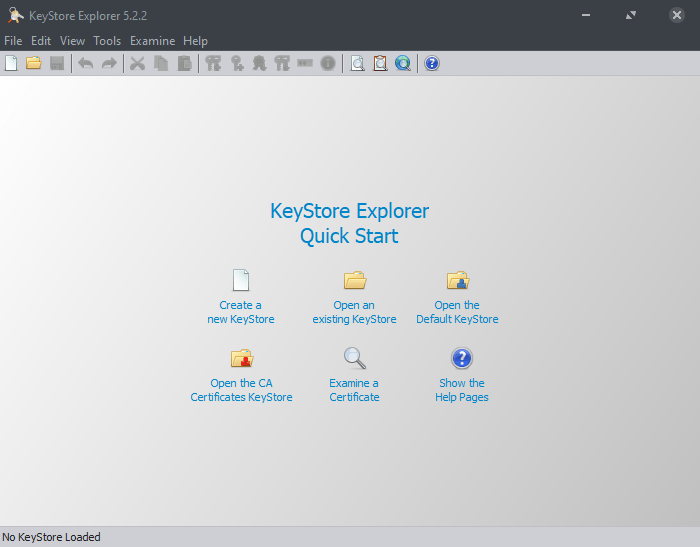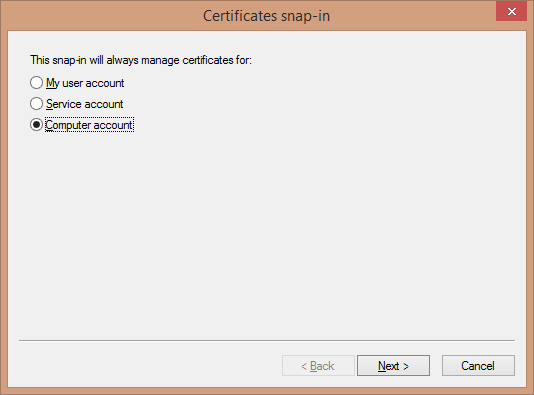

- #Keystore explorer to p7b password#
- #Keystore explorer to p7b download#
Once done, please restart Tomcat in order to apply changes.If you are not quite sure about the steps to reproduce, you can go to this section to apply the changes and verify SSL installation.
#Keystore explorer to p7b password#
keystore_password is the actual password for your keystore. /opt/tomcat/ssl/yourkeystore.jks is the absolute path and actual name of the keystore file. Here is an example of the JSSE connector for port 443 using HTTP/1.1 protocol along with TLS up to 1.3 protocol versions: Most likely, it will be in /opt/tomcat/conf/server.xml or /etc/tomcat/server.xml You can find the location of the directory containing the server.xml configuration file by issuing the below command: 
The modification should be done in the ‘Tomcat installation directory’/conf/server.xml file.
certificate.crt is the actual actual name/path of your end-entity certificate file.Īfter import of the end-entity certificate, the below message will be prompted:Ĭertificate reply was installed in keystore Step 3: Edit the connector. If you did not specify the alias during the keystore creation, the default value will be mykey. The alias for your end-entity certificate should be the same as the one you used when creating the keystore with the Private key. tomcat is the actual alias of your keystore. Keytool -import -trustcacerts -alias tomcat -file certificate.crt -keystore yourkeystore.jks Import the end-entity certificate for your domain: intermediate_1.crt is the actual actual name/path of your first intermediate CA certificateĪfter the successful import of each of the above certificates, you should receive the following output:. intermediate1 is the alias of the imported first intermediate CA certificate. Keytool -import -trustcacerts -alias intermediate1 -file intermediate_1.crt -keystore yourkeystore.jks Import the first intermediate certificate: intermediate_2.crt is the actual name/path of your second intermediate CA certificate. intermediate2 is the alias of the imported second intermediate CA certificate. Keytool -import -trustcacerts -alias intermediate2 -file intermediate_2.crt -keystore yourkeystore.jks Import the second intermediate certificate: Note: During import of the CA root certificate, you may be prompted with the following message.Ĭertificate already exists in system-wide CA keystore under alias ĭo you still want to add it to your own keystore? :ĭisregard the warning and confirm certificate import with submitting y. yourkeystore.jks is the actual name/path of the keystore file. root.crt is the actual name/path of your CA root certificate. 
root is the alias of the imported CA root certificate.Keytool -import -trustcacerts -alias root -file root.crt -keystore yourkeystore.jks

Step 2: Import the filesįollow the below steps in the given order to import the files properly. It may come in handy if you encounter the “ keytool error: java.langException: Failed to establish chain from reply” error.
#Keystore explorer to p7b download#
Here is the dedicated page with download links if you only need the CA bundle. You can download the certificate files from your Namecheap account along with the CA bundle. The above list is composed in reverse order on purpose as this is the exact order in which the certificates should be imported to the keystore. Note: The “AAA Certificate Services” is only installed if you chose the CA Bundle containing the cross-signed certificate. Here is an example of a JSSE connector for port 443 using the HTTP/1.1 protocol with TLS up to 1.3 enabled: It will most likely be in /opt/tomcat/conf/server.xml or /etc/tomcat/server.xml You can find the location of the directory containing the server.xml configuration file by issuing this command: In the next step, you will need to modify the connector for the default port 8443 or 443. Otherwise, the “ Input not an X.509 certificate” error may take place.Īfter you have imported successfully, you should receive the following output:Ĭertificate reply was installed in keystore Step 2: Edit SSL Configuration Make sure the certificate file has the same alias used for creating the keystore.
yourkeystore.jks is the actual name/path to the keystore file. certificate.p7b is the actual name/path to your certificate file. tomcat is the actual alias of your keystore. Keytool -import -trustcacerts -alias tomcat -file certificate.p7b -keystore yourkeystore.jks Then, import it using the following command: Upload the PKCS#7 certificate file on the server.








 0 kommentar(er)
0 kommentar(er)
